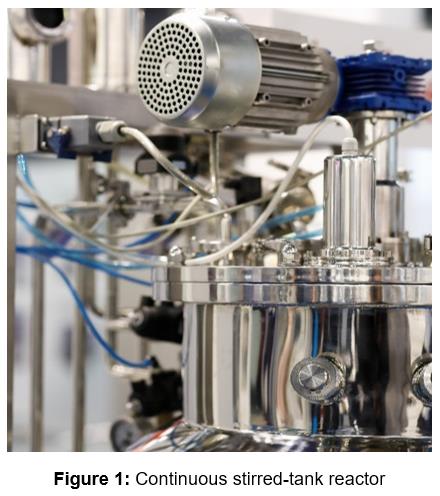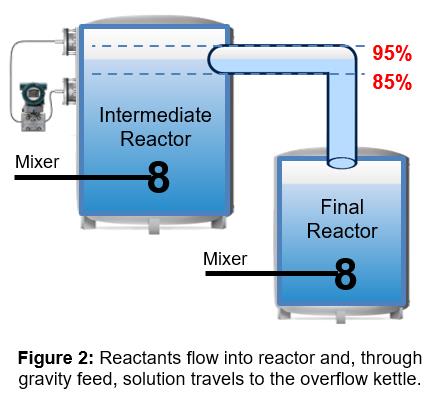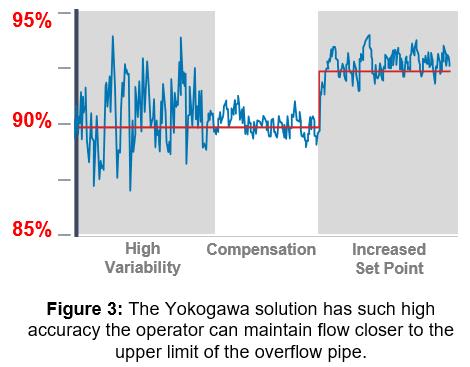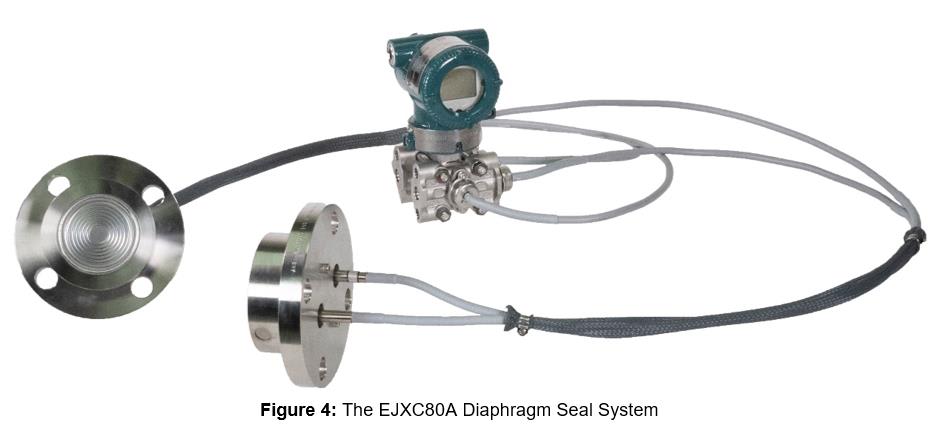Accurate reactor level measurement enables flow optimization to enhance yield.
 In one of its many production processes, a chemicals manufacturer in the United States draws from multiple reactant flow streams to fill an intermediate reactor. When the level reaches a certain point, an overflow pipe directs the solution to a kettle via gravity feed.
In one of its many production processes, a chemicals manufacturer in the United States draws from multiple reactant flow streams to fill an intermediate reactor. When the level reaches a certain point, an overflow pipe directs the solution to a kettle via gravity feed.
To optimize production, the chemicals manufacturer needs to maintain the level of the intermediate reactor as close to the top of the overflow pipe as possible without endangering process safety, between 85% and 95% of the reactor.
Process control is based on the feeds flow rate into the reactor rather than a traditional level application that uses a control loop.
Because an operator controls the reactant valves, it is important for the operator to have accurate level readings to maximize the gravity feed without interrupting the process.
The most common form of level measurement in this type of application is a differential pressure (DP) transmitter that measures the difference between two  pressures and calculates the tank level.
pressures and calculates the tank level.
Control of the process is based on the flow rate of the feeds into the reactor rather than a traditional level application that uses a control loop. Because an operator controls the reactant valves, it is important for the operator to have accurate level readings to maximize the gravity feed without interrupting the process.
The most common form of level measurement in this type of application is a differential pressure (DP) transmitter that measures the difference between two pressures and calculates the tank level.
Challenges
The primary challenge was to maintain safely the highest possible level in the overflow pipe. The tank level monitor they used had too much deviation in the measurement and the operator could not be sure of the exact level, so they maintained the operating set point target low. Uncertainty in the pressure measurement arose because as the ambient temperature changed, the pressure seemed to change. For example, when the sun heated the transmitter, the pressure reading increased, which made the level reading rise erroneously.
The difference between reality and the level measurement using a standard DP could be anywhere between 5% and 8%. Operators knew that with less deviation in the level measurement, the tank level could be kept higher confidently and remain closer to the goal level for maximum output.
Solution
 The chemical manufacturer chose to change their level measurement to Yokogawa’s EJX-A series of DPharp transmitters with compensating capillaries. This solution delivers a smaller deviation of at most 1.5%.
The chemical manufacturer chose to change their level measurement to Yokogawa’s EJX-A series of DPharp transmitters with compensating capillaries. This solution delivers a smaller deviation of at most 1.5%.
Thanks to improved measurement accuracy, operators can hold the level of the outflow pipe higher than previously possible—without worrying they will fully submerse the pipe.
In fact, because the measurement deviation is so small, the chemical manufacturer has decreased the difference between the operator target and the specified upper limit.
The benefits arise from Yokogawa’s unique compensating capillary solution that adds a capillary tube on the high-pressure side of the transmitter, which balances the volume of fill fluid with the capillary on the low-pressure side. In this way, the high- and low-side fill fluids can be exposed to the same environmental conditions while reducing errors caused by changes in ambient temperature.
Key Advantages
 Operators can permit the flow to be closer to the upper limit because the level measurement is highly accurate.
Operators can permit the flow to be closer to the upper limit because the level measurement is highly accurate.- Higher product yield due to reduced deviation in level measurements.
- Improved efficiency of the process due to more confident control of flow rates.
Industries
-
Chemical
Chemical plants rely on continuous and batch production processes, each posing different requirements for a control system. A continuous process calls for a robust and stable control system that will not fail and cause the shutdown of a production line, whereas the emphasis with a batch process is on having a control system that allows great flexibility in making adjustments to formulas, procedures, and the like. Both kinds of systems need to be managed in available quality history of product, and to be able to execute non-routine operations. With its extensive product portfolio, experienced systems engineers, and global sales and service network, Yokogawa has a solution for every plant process.
Related Products & Solutions
-
EJXC80A, EJAC80E (Differential / Gauge Pressure Diaphragm Seal)
Differential / Gauge Pressure Diaphragm Seal System with one or two Diaphragm Seals
-
Diaphragm Seal System
Protect transmitters’ pressure-sensing assemblies with field-proven diaphragm seal solutions.
-
Differential Pressure Transmitters
Monitor and communicate pressure measurements with traditional mount or remote diaphragm seal mount transmitters.
Have Questions?
Contact a Yokogawa Expert to learn how we can help you solve your challenges.